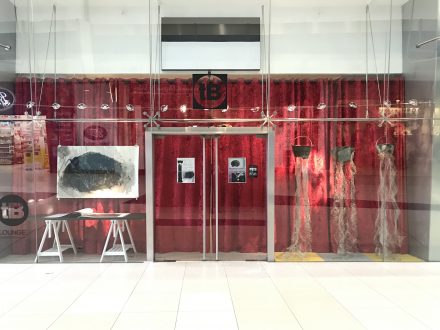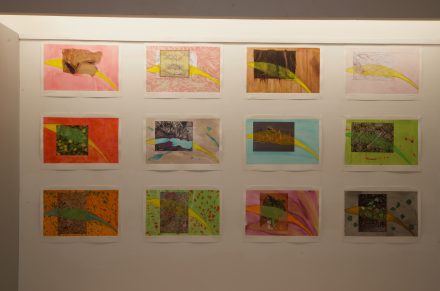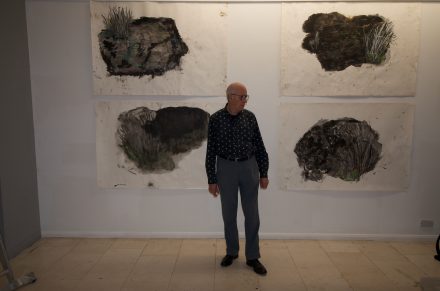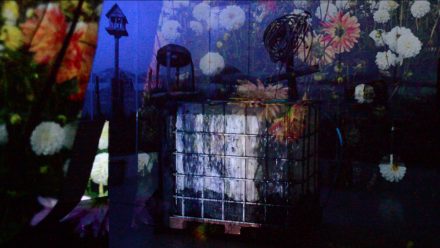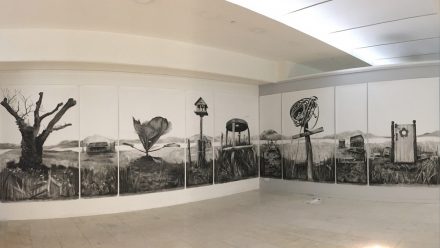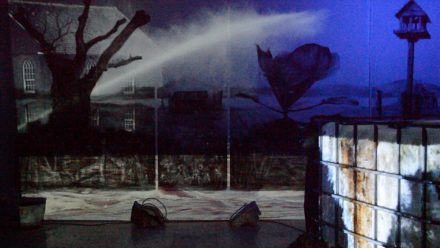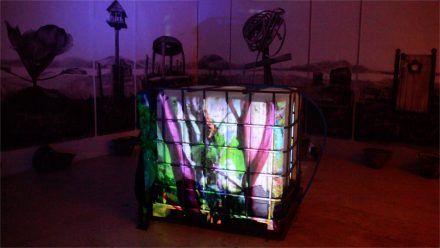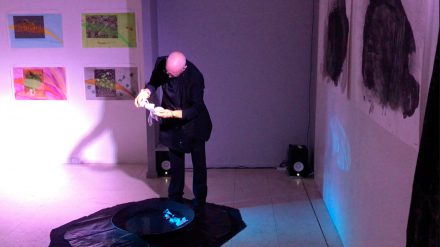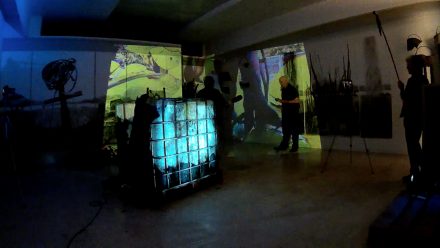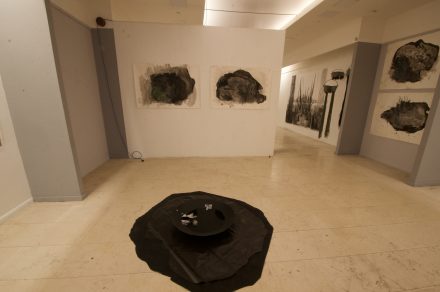Dr Frances Woodley, Steven Hitchins, Lyndon Davies: Responses to the ‘Materials from the Garden’ Exhibition
The joint exhibition of works by Penny Hallas and Allen Fisher, described here, took place in September 2021 at tactileBOSCH in Cardiff. Two of the following reports also allude to an evening of poetry, music, projection and performance featuring the artists.
Lyndon Davies
The exhibition is spread over two rooms. Entering the first, which houses Allen Fisher’s contribution, you are struck firstly by a sense of space–almost of spareness–and order, then immediately after by the divergence between a wall of intensely coloured jewel-like images and two walls of very dark ink and water-colour paintings. The first wall of multi-media works on paper, arranged in a tight grid, is from a series called ‘proceeds in the garden’. Bright, energetic, lustrous, it grabs the eye. Fisher situates this work partly in relation to Dante’s Paradiso and that connection rings true in the brilliance of the colouring and in the spritely broken orderliness of the rhythms, those shifting repetitions of rectangles and a kind of frond- or fish- or lightning-like design leaping diagonally across the picture surfaces. Fisher speaks of these works as inspired by momentary experiences of joy and uplift, little glimpses of paradise encountered in the daily passage through life, in a book, in the street, in a human relationship, in the garden or the allotment. We see images sometimes clearly figuratively legible, images for instance of plants, vegetables, a map, a cell, and sometimes less easily interpretable. In a corner of the room we can hear Fisher quietly reading his Dante-saturated ‘proceeds in the garden’ poems.
The other walls are taken up with Fisher’s Black Pond paintings (or drawings – I’m not sure how to describe them), an altogether more sombre series. These, on large sheets of thick paper, nailed to the wall, were made on location on a raised peat bog in the hills above Llangattock in Powys, and the paper bears all the traces of having been wrestled down on the rough grass around one of the little ponds there, slightly spattered and smeared and worked on heavily. Each bears a drawing of the pond, the tonality ranging through very black to paler greys, overlaid here and there with flushes and prinks of colour, mainly grassy or glaucous greens with bits of yellow. The mark-making is free, as if rapid, with a real air of kinetic attack. For me, emotionally and metaphorically these drawings/paintings evoke a fantasy of solitary or post-human spaces, spaces of night and forgetting, entrances perhaps to some kind of underworld, stains, blotches on the pallid surface of memory and consciousness. This effect is strengthened by the presence of a large black bowl on the floor, filled with black water and containing torn and soggy scraps of paper with bits of smudged writing still visible on them, Fisher’s own, the remnants of an earlier performance. Conceptually vivid, when looked at closely the drawings have a beguiling material richness and vitality of detail which seems partly to gainsay their more stygian echoes. So there is a tension there which is doubled in the room by the dialogue between the two bodies of work.
To slip through the open door between the Black Pond paintings into Penny Hallas’ space is to experience a transition wholly congruent and yet startling. This new room is both dark and full of light from projected images. Your eyes have to settle. In the middle of the room is a big scruffy white plastic water-butt, cube-shaped, onto which a film alternating between images of torrential streams and a video journey through plants on an allotment is projected. Around three walls a series of tall narrow charcoal drawings of objects, trees and plants on the allotment set against a kind of continuous landscape are pinned up, rather hazy in the gloom. Normative hierarchies of scale are scrambled: a cabbage is as big as an oak tree, as if in this imagined landscape a process of recalibration is under way, where the relation of things has to be discovered anew and the import of the natural and the human brought into a different kind of balance. At the foot of the walls under these drawings, and sometimes hanging up, are rows of old rotten rusty buckets, some with bunches of thin wire pouring from them like fossilised water. In a time of threatening ecological catastrophe with its vibratory alternations between flood and drought, these can be read as potent images for the disintegration of the human project for self-nurturing and control of natural forces. This theme is given even more powerful expression in the double video projected on the inner wall of the room. This is a video of the water-butt actually in situ on the allotment, under one of the big oak trees depicted in the drawings. It’s twilight and as the light slowly fades in the sky images of flooding water play over the water butt in one film while on the other the journey through the plants plays out. Birds sing their twilight songs on the soundtrack while from time to time we hear a quiet voice pronouncing the words ‘flood’, ‘water’ and ‘to water’ in many languages. There is a melancholy in this fading back into the dark which chimes with Fisher’s deeply meditative Black pond drawings, a melancholy which could almost seem to speak for all humanity and for nature itself in this shared moment of global threat. The theme of water is also another strong connective link between the two bodies of work in their separate rooms: Fisher’s pond situated in the hills above Llangattock, forming part of the groundwater system filtering down to supply Hallas’ solar-powered allotment water system.
An intriguingly varied but powerfully cohesive joint-exhibition.
Lyndon Davies has published six collections of poetry, most recently Bridge 116 (Aquifer 2017), Canalchemy:The Materials (Aquifer 2019) and Reset (Aquifer 2019) and a book of essays titled Resemblance(Aquifer 2019). He runs the Glasfryn Seminars, a series of discussion groups on aspects of literature and art. With poet John Goodby he organises live and zoom poetry readings with an experimental bias, called The Poetry Jamboree. With artist Penny Hallas he coordinates multi-media semi-improvised happenings called Ghost Jam.
Dr Frances Woodley
Materials from the Garden
The heart of the Black Mountains had been formed by an ancient river, flowing for many millions of years from an old red continent. From the edges of volcanoes, from scree-strewn uplands, across plains of mud, the great river had meandered across a coastal plain to the sea, bringing down mud, silt and sand, coloured by hematite. It had laid these in shoal and floodbank, bed upon bed. People of the Black Mountains, Raymond Williams.
The allotment, out of which Penny Hallas’s work for Materials from the Garden exhibition has grown, lies upland from the River Usk and below the Monmouthshire and Brecon Canal surrounded by panoramic views of the Black Mountains. Standing on her allotment, facing North East looking beyond Crickhowell on the opposite bank of the river are Pen Cerrig Calch and beyond that, Crug Mawr. It is here, in comfortable proximity to her home, and approached by two riven trees along its edge and entrance, that the artist and others tend their allotments. It’s late October, so the warted gourds scramble, the cabbages threaten to go rogue, and copper-coloured turnips shoulder their way through the earth’s damp crust. The allotments, some of them fortresses against rabbits and rats, are also home to idiosyncratic allotment furniture – a miniature door, a Tyrolean bird table, a serpentine-legged, pale blue metal stool and a similarly pale blue hosepipe that snakes its way around a pair of faded plastic chairs. All this, and the water system of pipes and butts that sustains the allotment’s produce, takes root in the exhibition.
The exhibition, an installation of drawings, paintings, video and found objects, is situated in a shopping centre in Cardiff. The empty retail outlet, a barren space, is brought to life by the artistic dialogue between Hereford-based Fisher and Crickhowell-based Hallas, a connection that also extends into their lives and landscape in the Black Mountains, through the flow of water.
Hallas’ floor to ceiling drawings that line the walls are presented as a myriorama, an interchangeable and imagined panoramic landscape view, a format previously used in works exhibited in Finland and Davies Gallery here in Wales. Rendered in monochrome, with charcoal, wax crayon and wash, their viewpoint is low, making the scale of the objects they depict, huge. The viewer feels their own smallness. It is the objects, trees and vegetables that exert their agency now, not the gardener or the viewer. The myriorama draws its viewers into its singular dramas of lone objects, as they stand erect, neglected, abandoned or lost in this regulated landscape. Wateriness and mistiness envelopes them but they stand firm. Encountered up close and personal, they are nevertheless monumental.The low horizons behind them with the upper two thirds of the drawing often left empty, catch the quality of light experienced on the allotment but might also be taken for a melancholic emptiness. This, however, is offset by the myriorama’s association with the eighteenth-century picturesque which effectively positions it as the inversion of the panoramic sublime.
The artist is not alone in adopting these pictorial tactics. Margaretha de Heer ((1603-c.1665) painted a huge red cabbage on a tall stalk, quite alone and towering over an imagined landscape. It speaks of an affectionate treasuring that I also see in Hallas’ polished rendering of a massive young cabbage. John Crome did much the same with his painted Study of Flints (c.1811) in which the small and insignificant chipping is elevated in scale and significance over the landscape from which it was broken. And Tacita Dean perhaps, in her filming of the WWI sound mirrors on the Kent coast in 1999. It amounts to an inflation of the object that verges on the surreal.
But there is also unease in these drawings, a liminality at the boundary of earth and sky, dawn and day, the real and the imagined – they are so close. Something of Paul Nash’s wartime painting of charred and churned up landscapes such as in We Are Making a New World(1918) come to mind, in which nature is painted as abandoned, left to lick its wounds and repair itself. There is a heartfelt concern expressed in this myriorama for the wellbeing and perpetuation of a landscape, its systems and the infrastructural and social networks required to feed, water, nurture and preserve it. Poetic imagination and aesthetic transformation are put to work by the artist to act on the viewer, to make them aware of the big questions facing every one of us about the world we inhabit so greedily. Images of objects, whether moving or static, made with coloured light or monochrome markings, are not simply the things they depict, they are fluid and vapourish metaphors – seductive warning signs.
The installation also has its moments of pure theatre. The water butt is brought to life as night time projection screen for frenzied branches. A video is projected across a corner so that flood water, spouting and flowing, appears to invade the drawings and animate the abandoned fragments of metal buckets that dangle in front of it. The windy watery whine of the saxophone played as live accompaniment, suggests a moaning. As Sebald speculates in Saturn’s Rings; ‘. . . perhaps there is something else as well, something nebulous, gauze-like, through which everything one sees in a dream seems, paradoxically, much clearer. A pond becomes a lake, a breeze becomes a storm, a handful of dust is a desert, a grain of sulphur in the blood is a volcanic inferno. What manner of theater is it, in which we are at once playwright, actor, stage manager, scene painter and audience?’ Or in in this case, artist, curator and conservationist too?
Steven Hitchins
Stalks of black chalk lacquered thick and opaque. Grass grown up around the legs of a metal stool. A fenceless gate in the middle of the field. A crossshaped old post crowned with a tangle of hosepipe. Abandoned buckets and tin pans. Ash smudge of hills in distance. Charcoal panorama.
In the centre of this circle of arable detritus stands, like an altar, a large oblong waterbutt. Its plastic sides fluoresce with the images that slosh through the waters within: a bee’s-eye view nosing through luminous chlorophylls and neon magentas of chard. Hovering close-ups of rubbery reptilian crinkle-curls warping a hexagonal webbing.
Allen in rubber gloves and black apron drops a sheaf of poems into a bowl of ink, which could be a peat bog, shallow and wide like a huge pupil in the ground. He lifts a sodden page from its obsidian well. As the paper ribbons wetly through his gloved fingers, he reads tau-tangled fragments of Milton. Page-tatters melt back into the bog, the words evolving into Dante’s Paradiso: glimpses of words like ‘harmony’, ‘joy’, ‘concordance’ incongruous amid consumer litter: an old Fruit Pastilles wrapper, a tub saying Marmite or maybe McVities.
Lyn is standing in the flood at the end of the street blowing his sax as a jet from a burst pipe arcs overhead. A jet of chalk. Spindrift wafts undulating in the melancholy dissonance of sax. The images from the waterbutt now begin to flow across him and out of him as he traces the ribs of glinting intervals veining the waxy epidermal scrunch. We are burrowing in flight along brassica architectures iterating elephantine billows that bloat along the stems in baggy folds of cruciferous bubblewrap.
Steven Hitchins edits The Literary Pocket Book press, producing miniature origami-style pamphlets of contemporary experimental poetry. Recent publications include Black Fens Viral by Frances Presley and NONglyns by Rhys Trimble and Harry Gilonis. In 2017-18 he ran Canalchemy, a series of walking-poetry events along the route of the now erased Glamorganshire canal from Merthyr Tydfil to Cardiff Bay, which fed into his most recent poetry collection, The Lager Kilns, available from Aquifer Books. His other books include Ilan (2018), The White City (2015) and Bitch Dust (2012), as well as the collaborative books Brynfab Collider (2019) and Yth (2015) both with Rhys Trimble, Winter Texts with John Maher (2016), and Translating the Coal Forests with Camilla Nelson (2015). His poetry has featured in the anthologies The Edge of Necessary and Imagined Invited, as well as the Welsh innovative poetry edition of Blackbox Manifold (Issue 25). His book-work ‘a conduit or line of pipes’ is currently part of the travelling exhibition ‘Without Borders’ curated by Elysium Gallery and 1SSUE magazine. https://literarypocketblog.wordpress.com
Click here to go back to: Contributors and Links to Pages 1 – 4
From the Junction Box
- Contributors and Links to Pages 1- 4
- Editorial to Issue 17: The John James / Chris Torrance Special
- Gavin Selerie: Marks Outside the Spa
- Elisabeth Bletsoe: Two Poems and a Miscellany for Chris Torrance
- Allen Fisher: Leeks and Leaves for Chris Torrance
- Ian Brinton: Notes from a Correspondence with Chris Torrance
- Elaine Randell: Chris, Barry and Me
- Ian Davidson: Tripping
- Peter Finch: Torrance
- Tilla Brading: Pieces for Chris Torrance
